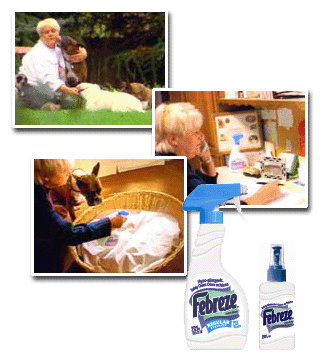 你一定还记得电影《侏罗纪公园》的一幕:琥珀中是一只史前的蚊子,用针提取那只蚊子体内的恐龙血液,再给采集的血液施加一点科学魔术,恐龙的DNA就能让这些已经灭绝的霸王龙起死回生。如果这种奇迹也能发生在美国大公司的身上该多好啊!
你一定还记得电影《侏罗纪公园》的一幕:琥珀中是一只史前的蚊子,用针提取那只蚊子体内的恐龙血液,再给采集的血液施加一点科学魔术,恐龙的DNA就能让这些已经灭绝的霸王龙起死回生。如果这种奇迹也能发生在美国大公司的身上该多好啊!
那么,我非常荣幸地宣布,一个历史悠久的美国公司就曾把一种新生产品的DNA注射到它175高龄的体内。这个公司中的恐龙非宝洁莫属。
像许多人一样,我经常对《纽约时报》关于公司是如何运用大量数据预测出消费者行为的文章深深着迷。其中特别吸引我的一篇便是宝洁如何把它的空气清新剂纺必适(Febreze)从公司的垃圾桶中救出来的故事。
在此期间,宝洁不仅对消费者心理施展了非凡的洞察力,而且向人们展示了它可以让新生产品实现变革的能力。
目前为止,与纺必适的最终成功关系最大的就是,它在初始阶段便主动尝试一些方法,然后得到消费者的反馈,再从反馈中学习,最后再进行尝试,直到成功。我在 Juntos Finanzas和PayPal(支付宝)的案例中就已经写到过这一点,不过只是举了几个例子。
正如《纽约时报》评论的那样,宝洁运用心理学原理帮助纺必适从几乎灭亡变得强大。人们是会形成习惯的——比如,第一次学习把车从停车场倒出来时,你必须记住许多听起来很复杂的步骤。但是很快这就变成你的习惯了。从那以后,每次需要把车从停车场倒出来时,你只需要以下三个步骤:引导——形成习惯的诱因;执行——本能地执行习惯性的活动;回报——因为执行这些规则从中得到的回报。
宝洁发现了一点——这正是从失败中学到的——纺必适最初的营销计划是有问题的,因为那个计划要求消费者改变他们原有的生活习惯。而当宝洁最终找到了一种方法,使纺必适遵循了人们原有的生活习惯时,销售跟着提高了。
20世纪90年代中叶,宝洁开始研发一种“可以消除异味”的新产品。根据《纽约时报》的报道,宝洁“花费了数百万美元用于开发一种无色、造价低廉的液体,喷洒在有烟味的衬衫、有异味的沙发、旧夹克或被污染的汽车内饰上时可以使异味消除。”
当纺必适即将走向市场之际,宝洁在找到一个成功营销它的方法之前就失败了。刚开始,宝洁把纺必适定义为一种可以从祛除衣服异味的产品——例如烟味。但是,经过数月这样的营销之后,销售额却更加糟糕了。
因此,宝洁开始用与消费者对话的方式调查原因。宝洁的研究人员采访了凤凰城一位非常擅长持家的女性——她家里养了9只猫。当研究人员走进她的房子时,让人难以忍受的恶臭扑鼻而来,“他们其中的一个甚至当场吐了”。但是,这个房子的女主人却认为她的房子气味很正常,并大喊道,“这种感觉不是很好吗?他们几乎什么也闻不到!”
宝洁从这次采访中学到了,与凤凰城这位爱猫女士一样,好多人已经形成了习惯,他们对日常生活中的恶臭已经麻木了。因此,由异味引发的、以保持家中空气清新作为回报的纺必适销售计划注定会彻底失败。因为在顾客眼中,他们的家中并没有任何异味。
值得赞扬的是,宝洁并没有放弃。它从哈佛商学院雇了一位研究者,并观看了一些顾客的采访视频。结果,斯科茨代尔一位名叫Ariz的女性为纺必适的营销人员提供了一条线索。
每打扫完一个房间,她就会在地毯上喷一些纺必适——然后,她热情地说道,“这样不是很好吗?当我搞定一个房间之后,再喷点它,放佛是在做一个小小的庆祝。”如果按照她的使用速度,宝洁团队“预计每两个星期她就会消灭一瓶纺必适,”根据《纽约时报》报道。经过进一步的分析,宝洁认识到只有把纺必适重新调整到消费者已经形成的清洁习惯的位置,它才有可能成功,而不是试图开创一种新的使用方法。针对此,他们特地做了一期广告,把纺必适当作打扫房间之后的奖励来销售。
宝洁的新广告中有一扇打开的窗户,外面的新鲜空气吹了进来。它还给纺必适的成分中加入了香水,为它设计的广告中,女主角把“纺必适喷洒在刚铺好的床上,和刚洗好的衣服上。”每一则广告都在把纺必适融入到人们现有的清洁习惯中。
它包含了引导——一个刚打扫过的房间;执行——给那个房间再喷点纺必适;和回报——享受“那种已经完成一件伟大工作的气味”。1998年夏天,经过两个月的营销改进,纺必适的销售额增长到原先的两倍。截至1999年,纺必适的营业总额达到2亿3000万美元。从那以后,纺必适开始不断引进它的副产品,这些副产品的收入在全年销售额中的份额如今已经超过10亿美元。
把宝洁比作一个被科学魔术起死回生的史前恐龙,这似乎有点不公平。但宝洁生存这么久的原因之一便是它找到了一个方法,这种方法能把一个新生产品的DNA注入这个拥有175年历史的企业巨人的基因。
幸亏有了纺必适的成功逆转,宝洁的底线闻起来味道更好了。
You must remember the scene from Jurassic Park where a needle extracts dinosaur blood from a prehistoric mosquito frozen in amber. With that blood and some scientific magic, the DNA of the dinosaur is used to bring those extinct T-Rex’s back to life. If only it was possible to do the same with big American companies!
Well I am happy to report that there is one old American company that’s managed to inject the DNA of a start-up into its 175-year-old hide. That corporate dinosaur is none other than Procter & Gamble (PG).
Like many people, I was fascinated by the New York Times article on how companies use big data to predict their customers’ behavior. One part of it that caught my eye was the story of how P&G rescued its air freshener, Febreze, from its corporate dustbin.
In so doing, P&G not only applied remarkable insights into human psychology. It also demonstrated its ability to apply some of the best things that let start-ups innovate.
Of these, by far the most relevant one to Febreze’s ultimate success is start-ups’ ability to try something, get feedback, learn from the feedback and try again until they succeed. I have written about this in the cases of Juntos Finanzas and PayPal to name just a few examples.
You can read more about their stories by following the links, but the basic idea is that start-ups excel at failing fast and doing what’s dubbed, composting, to use the analysis of the failures to provide the intellectual nutrition required to propel the start-up to an eventual discovery of a workable solution.
As the Times explained, P&G applied principles of psychology to turning Febreze into a huge business after it nearly perished. People form habits — the first time, say, you learn how to back a car out of garage, you have to remember a dozen seemingly complex steps. But soon it becomes second nature.
Whenever you need to back out of the garage after that, you go through a three stage process: cue — something that triggers the habit; routine — where you instinctively perform the habitual activities; and reward — where you get some pleasant outcome as a result of performing the routine.
What P&G discovered — after a failure from which it learned — was that its original approach to marketing Febreze was wrong because that approach required consumers to change their habits. When P&G ultimately discovered a way to make Febreze part of an existing routine, sales exploded.
In the mid-1990s, P&G started work on a new product “that could eradicate bad smells.” According to the Times, P&G ”spent millions developing a colorless, cheap-to-manufacture liquid that could be sprayed on a smoky blouse, stinky couch, old jacket or stained car interior and make it odorless.”
When Febreze was ready to go to market, P&G failed before finding a way to market it successfully. The first time, P&G marketed Febreze as a way to make remove odors — such as cigarette smoke — from peoples’ clothes. But after months of trying to pitch Febreze that way, sales went from bad to worse.
So P&G began investigating why by talking to consumers. P&G researchers visited a woman in Phoenix who kept a very well organized house — that hosted nine cats. When the P&G researchers entered the house, the stench was so overpowering that “one of them gagged.” But the woman of the house thought the house smelled fine and exclaimed, “Isn’t it wonderful? They hardly smell at all!”
What P&G realized was that people like the cat lover in Phoenix developed habits that desensitized them to the horrible odors in their lives. Therefore, selling the Febreze routine as the reward for a fresh-smelling home cuedby a bad smell was an utter failure because consumers thought their houses smelled fine.
To its credit, P&G did not give up. It hired a Harvard Business School researcher and watched videos of customer interviews. One woman in Scottsdale, Ariz. provided a clue to the Febreze marketers.
After she cleaned a room in her house, she sprayed the carpet with Febreze — and then enthused, “It’s nice, you know? Spraying feels like a little minicelebration when I’m done with a room.” At the rate she was going, P&G’s team “estimated, she would empty a bottle of Febreze every two weeks,” according to the Times.
After further analysis, P&G realized that it could only succeed with Febreze if they positioned it as part of an existing cleaning routine rather than trying to create a new one. Specifically, they came up with advertisements that sold Febreze as the reward for cleaning a room.
P&G’s new advertisement showed open windows and gusts of air. It added perfume to the Febreze formula and filmed commercials of women using “Febreze to spritz freshly made beds and just-laundered clothing.” Each of its commercials fit Febreze into an existing cleaning habit.
It included the cue – a freshly cleaned room; the routine– spraying that room with Febreze; and the reward – relishing “a smell that says you’ve done a great job.” Within two months of the summer 1998 marketing revamp, Febreze sales doubled. By 1999, Febreze revenues totalled $230 million. Since then Febreze has introduced spinoffs that account for over $1 billion in annual sales.
It’s unfair to liken P&G to an extinct dinosaur brought back to life by a miracle of science. But one of the reasons that P&G has been able to survive for so long is that it has found a way to inject the DNA of a start-up into the corporate genetic code of a 175 year old giant.
And thanks to its Febreze turnaround, P&G’s bottom line smells much sweeter.
 你一定还记得电影《侏罗纪公园》的一幕:琥珀中是一只史前的蚊子,用针提取那只蚊子体内的恐龙血液,再给采集的血液施加一点科学魔术,恐龙的DNA就能让这些已经灭绝的霸王龙起死回生。如果这种奇迹也能发生在美国大公司的身上该多好啊!
你一定还记得电影《侏罗纪公园》的一幕:琥珀中是一只史前的蚊子,用针提取那只蚊子体内的恐龙血液,再给采集的血液施加一点科学魔术,恐龙的DNA就能让这些已经灭绝的霸王龙起死回生。如果这种奇迹也能发生在美国大公司的身上该多好啊!
